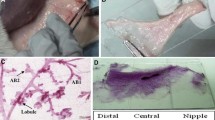Abstract
Polygonum hydropiper is a widely grown weed in the north-eastern states of India. In the present study, estrogenic effects of the crude root extract (CRE) ofPolygonum hydropiper on uterine protein was tested in ovary-intact and ovariectomized (OVX) female albino rats. The methanolic crude extract ofPolygonum hydropiper was given to adult ovary-intact and OVX female albino rat in a dose of 1000 mg/kg bodyweight per day. Oral administration of the CRE was carried out for a period of 12 days from the onset of proestrus and for a similar period of time for the OVX female. To study the estrogenic effect, OVX females were subcutaneously injected with 0.1 μg of estradiol-17β (E2). E2 was injected at the interval of 24 h for a total period of 72 h. The uterine protein of ovary-intact and OVX females was studied by single dimensional sodium dodecyl sulfate polyacrylamide gel electrophoresis. The results showed similar protein bands in OVX females treated with E2 and CRE. In addition, treatment with CRE stimulated expression of more proteins in the uterus. The results showed that CRE ofPolygonum hydropiper mimics the effect of estradiol-17β in the uterine protein profiles of adult female albino rats.
Similar content being viewed by others
References
Garg SK, Mathur VS, Chaudhury RR. Screening of Indian Medicinal Plants for antifertility activity.Indian J Exp Biol 1978;16: 1077–1079.
Prakash AO. Potentialities of some indigenous plants for antifertility activity.Int J Crude Drug Res 1986;24: 19–24.
Sarma HN, Mahanta HC. Effects of composite root extract on certain biochemical components in uterine tissue of albino rat.J. Exp. Zool India 2001;4: 121–126.
Kirtikar KR, Basu BD.Indian Medicinal Plants Lalit Mohan Basu, Allahabad 1935; Vol. III: 21 000–21 002.
Zhao Feng Peng, Dieter Strack, Ramanathan Subramaniam, Alfred Baumert. Antioxidant flavonoid from leaves ofPolygonum hydropiper Linn.J Phytochemistry 2003;62: 219–228.
Hogan B, Constantini F, Lacy E.Manipulating the Mouse Embryo: A Laboratory manual. Cold Spring Hurbor: Cold Spring Hurbor Laboratory, 1986.
Frederic M Ausubel, Roger Brent, Robert E Kingstonet al.Short Protocols in Molecular Biology, 5th edn. Canada: John Wiley and Sons, Inc., 2002.
Kuivanch PC, Desombre IR.J Steroid Biochem 1985;22: 439.
Stewart CL, Cullinan EB. Preimplantation development of the mammalian embryo and its regulation by growth factors.Dev Genet 1997;21: 91–101.
Carson DD, Bagchi I, Dey SKet al. Embryo implantation.Dev Biol 2000;223: 217–237.
Devarshi P, Patil S, Kanase A. Effect ofPlumbago zeylanica root powder induced preimplantationary loss and abortion on uterine luminal proteins in albino rats.Indian J Exp Biol 1991;15: 650–652.
Author information
Authors and Affiliations
Corresponding author
About this article
Cite this article
Hazarika, A., Sarma, H.N. Polygonum hydropiper crude root extract mimics estrogenic properties in females: Evidence of uterine protein profiles studied by sodium dodecyl sulfate polyacrylamide gel electrophoresis. Reprod Med Biol 5, 155–160 (2006). https://doi.org/10.1007/BF03016151
Received:
Accepted:
Issue Date:
DOI: https://doi.org/10.1007/BF03016151




